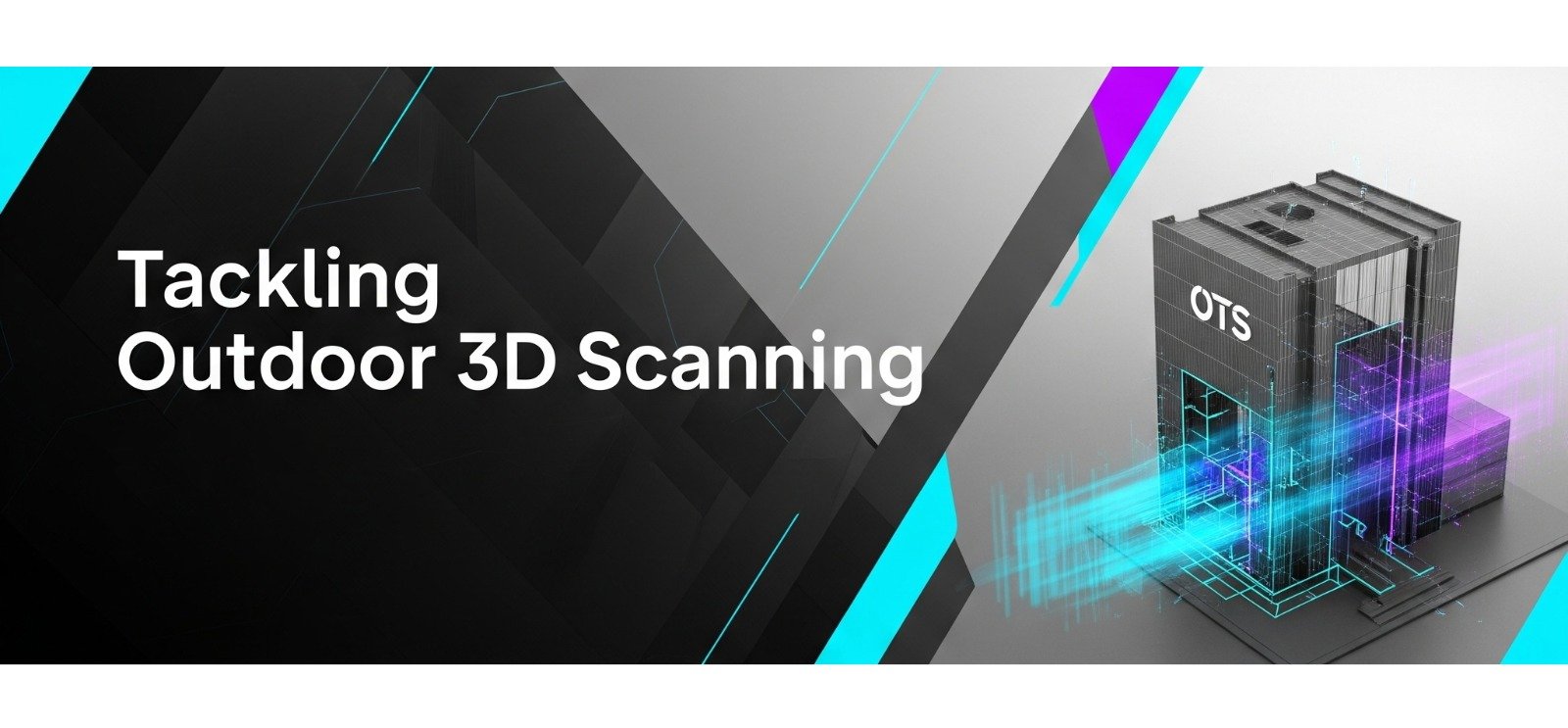- Your cart is empty Browse Shop

Tackling Outdoor 3D Scanning: An Engineer’s Field Notes from the Ground
Unpredictable outdoors, predictable pressure : Capturing a large-scale 3D scan with precision and on schedule.

Scanning small parts indoors makes life simple. Stable light, dry surfaces and no chance of rain intruding.
Move that same operation outdoors; a solar power field in Lahore , Pakistan packed with reflective parabolic panels, and the rules change fast.
Let’s go behind-the-scenes to delve into how the OTS technical team successfully scanned a large, complex solar structure in the great yonder. It’s part story, part survival guide, packed with field-tested engineering insights.
Moisture, Markers & Morning Dew
The day started early, as did the problems. Each solar panel was glazed with condensation. Reference markers, essential for alignment, simply wouldn’t stick. So OTS presented this as solution:
- Surface Prep Formula: 1:1 mix of petrol and paint thinner was used to quickly clean and dry the surface
- Heat Gun Assist: Panels were gently warmed to evaporate residual moisture
Result: Markers held firm, and the scanning started!
Note: This approach requires caution due to flammability: ensure proper ventilation and avoid open flames.
When the Weather Doesn’t Care
Overcast conditions needed special disaster aversion measures. To minimize risk, we developed a “Rapid Retreat Protocol”:
- Scanners and laptops were mounted on rolling carts
- Gear was kept under waterproof covers
At the first sign of rain, everything was wheeled indoors in a matter of minutes. Instead of losing time, that break was used to process the scanned data. The scanning stopped, work didn’t.
Working at Height: The Real Safety Test
A retrofitted wobbly platform was the only means available to access the top of the solar structure.
To ensure safety:
- Full-body harnesses were worn
- Scanning gear was lifted separately using secured ropes
- Constant communication between ground and elevated teams minimized potential risks
Lesson learned: Always request proper scaffolding or certified lifting equipment. Stability ensures both operator safety and scan accuracy.

Reflective Surfaces vs. Sunlight
overwhelmed the sensors, filling the dataset with noise and distortions.
The Fix:
- Repositioned the dish away from direct sunlight
- Scanned during cloud cover or early/late hours of the day
- Shading panels were improvised where needed
Result: Cleaner point clouds and fewer scanning artifacts
How AI, IoT, and Digital Innovation Are Revolutionizing Industries & Shaping the Future of Work
The Industry 4.0 revolution is transforming traditional industries through the integration of AI, IoT, and digital technologies. These innovations are not only enhancing efficiency, safety, and productivity but also redefining the future of work by enabling automation, real-time data insights, and intelligent decision-making. Let’s explore how these technologies are reshaping Aerospace & Aviation, Oil & Gas, Automotive, and Engineering (Process Industries).
Big Structures, Bigger Data
The sheer size of the dish called for segmented scanning.
- The surface was divided into overlapping sectors, each aligned with reference markers
- Datasets were stitched digitally with minimal tolerance error
- The high-resolution scans quickly ballooned to tens of gigabytes
Solution:
- Data was offloaded to external drives
- Post-processing was handled by a parallel off-site team.
Takeaway: Separate capture from processing. It’s the only way to beat the clock on large-scale projects

What the Field Teaches Us
This project reaffirmed a core belief at OTS: great field scanning isn’t just about having the right tools—it’s about engineering the right process.
From marker prep to weather planning and data management, small details made a big difference. And in the end, we delivered a complete, high-resolution point cloud under real-world pressure.
Key Takeaways from the Field
- Surface Prep Is Everything: Clean, dry, warm surfaces = reliable marker adhesion
- Weather-Proof Your Workflow: Protect your equipment and plan for rapid retreat
- Insist on Proper Access Equipment: Safety directly impacts scan quality
- Control Light & Reflection: Dish orientation and shading make or break accuracy
- Divide & Conquer: Segment large structures and align in post for precision
- Decouple Capture from Post-Processing: Parallel workflows accelerate delivery.
Final Thoughts
Field scanning under unpredictable outdoor conditions isn’t just possible. If engineered properly it is highly accurate and reliable. OTS’s successful capture of a full-scale solar structure proves it.
Interested in Field Scanning Services?
Reach out to OTS 📩 info@otspk.com | 🌐 www.otspk.com



